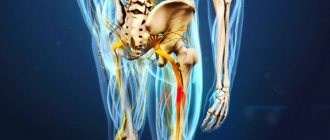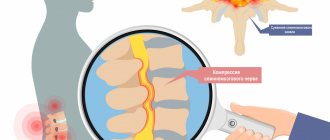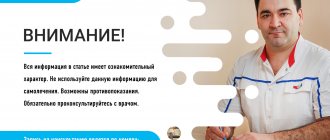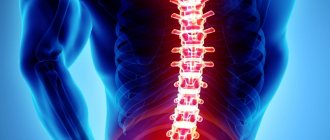Local NSAIDs for back and lower back pain
Nonsteroidal anti-inflammatory drugs (NSAIDs) are drugs that effectively suppress inflammation and have an analgesic effect by reducing the activity of the cyclooxygenase enzyme. As a result, the synthesis of prostaglandins, compounds that play a key role in the development of inflammation and pain, is disrupted. Most often, NSAIDs are used in the form of tablets and injections, but in this form they often lead to side effects - stomach ulcers, gastric bleeding, blood clotting disorders, and kidney failure. Side effects occur especially often with long-term use.
Shpidonov Gennady Stanislavovich
Neurologist
Rostov State Medical University (neurology)
10 years of experience
Chronic back pain requires long-term use of painkillers and anti-inflammatory drugs. But what to do about side effects? To combat them, local remedies are used in the form of gels, patches and ointments, which also have an analgesic and anti-inflammatory effect for back pain, but without the disadvantages characteristic of NSAIDs. The use of this group of drugs in the form of local therapy is safer than injections and tablets. The presence in such products of substances that facilitate the penetration of NSAIDs into soft tissues increases the effectiveness of treatment.
Creams, ointments and gels with NSAIDs also help with acute back pain. Moreover, it is recommended to start treatment with local therapy, and only if there is no effect, switch to taking pills or giving injections. This way you will prevent the side effects of NSAIDs, the use of which for more than 3-5 days without consulting a doctor is fraught with complications.
The most common ointments, gels and patches with NSAIDs used for back and lower back pain:
- Nise;
- Fastum Gel;
- Voltaren Emulgel;
- Ketonal;
- Nurofen Express;
- Finalgel;
- Ibuprofen;
- Diclofenac;
- Dolgit.
Local therapy is almost always less effective compared to pills and injections. However, if the pain is not severe, it is better to try using ointments, gels and transdermal patches with NSAIDs.
What medications can be used for sciatica?
The condition can be treated with several types of medications.
| Drugs | Description | Example |
| Non-steroidal medications | They have an analgesic effect and relieve inflammation. They do not cause dependence or addiction. They may not be able to cope with severe pain. |
|
| Steroid drugs | They can cope with severe pain. Produced from cortisol. |
|
| Antidepressants and sedatives | They have a relaxing effect, help the patient tolerate pain more easily, and improve attention and concentration. |
|
| Narcotic medications | Used only for acute burning pain that causes severe clouding of the condition | By injection or intravenously only in a hospital setting |
Injections against sciatica are used only in severe conditions when it is not possible to block the pain with conventional ointments and tablets. It is strictly recommended that injections be administered only by a healthcare professional.
Additionally, during treatment it is required to take vitamins and mineral biological supplements , which will improve the condition of all internal organs and the general psycho-emotional state.
Ointments with bee and snake venom
Bee and snake venom have been used for medicinal purposes since ancient times. A detailed description of such therapy is found in Hippocrates, Avicenna, Galen and many other healers. Modern research confirms the ability of bee and snake venom to have a number of positive effects in diseases of the musculoskeletal system and nervous system. The enzymes it contains (phospholipase, hyaluronidase, phosphatase), toxins, and biologically active substances have a locally irritating and distracting, reflex, analgesic and anti-inflammatory effect.
Under the influence of the poison, a reflex expansion of blood vessels occurs, microcirculation improves, the permeability of the vascular wall increases, regeneration is stimulated and tissue nutrition improves. Direct anti-inflammatory and analgesic effect relieves swelling and inflammation. The addition of excipients such as salicylic acid and mustard oil enhances the effect of ointments for back and lower back pain.
It is important to remember that the use of ointments with bee and snake venom is strictly contraindicated in case of allergies to bee products, polyvalent allergies, or a tendency to anaphylactic shock. In such patients, even small amounts of poison can cause severe allergic reactions, including swelling of the upper respiratory tract and anaphylaxis.
The most common ointments with bee or snake venom for back and lower back pain:
- Apizartron;
- Viprosal;
- Virapin.
Shpidonov Gennady Stanislavovich
Neurologist
Rostov State Medical University (neurology)
10 years of experience
Gels and ointments that increase blood circulation
Gels and ointments that increase blood circulation usually consist of capsaicin and its derivatives (the substance responsible for the spicy taste of pepper), other substances that have a vasodilating, warming and irritating effect. The drug helps to increase local blood flow, improves microcirculation, and due to intense burning on the skin, stimulates the natural mechanisms of pain control (distracting effect). Vasodilation and increased blood flow help improve metabolism in the underlying tissues, including those affected by degenerative and inflammatory processes.
Before starting use, it is recommended to carry out a test - allergic reactions are possible; in some patients with sensitive skin, the drug causes an intolerable burning sensation (in such cases, it is necessary to wash off the product with warm water and soap).
Common ointments that increase blood circulation for back and lower back pain:
- Nicoflex
- Finalgon
- Capsicam
Chondroprotective ointments for lower back pain
Chondroprotectors are drugs that have the ability to slow down the process of destruction (degeneration) of cartilage tissue and stimulate its regeneration. These are mainly glucosamine and chondroitin. There are various ointments with glucosamine and/or chondroitin, however, due to the fact that these substances do not pass through the skin well (they are high-molecular compounds), the effectiveness of these products is questioned. Chondroprotectors have the greatest effect when administered intramuscularly and orally, however, even in this case, several courses of treatment are required to achieve an effect.
Shpidonov Gennady Stanislavovich
Neurologist
Rostov State Medical University (neurology)
10 years of experience
Common chondroprotective ointments for back and lower back pain:
- Sofia Chondroitin glucosamine complex
- Chondroitin
Such products include various creams, ointments, gels and balms, recommended for back pain, and containing collagen, mumiyo, oils, including essential oils, extracts of medicinal herbs, alum, shungite, etc. The effectiveness of such drugs (Shungite, Dr. Theiss Comfrey with vitamin E, Valentin Dikul Balm) has not been tested by clinical studies, and remains on the conscience of the manufacturer.
Homeopathic ointments for back and lower back pain
Homeopathy is a branch of alternative medicine that uses the principle of similarity for treatment (like cures like). Homeopaths use ultra-low concentrations of various substances of mineral or organic origin as medicine. Numerous studies of the effectiveness of homeopathic remedies have not found the therapeutic effect described by adherents of homeopathy - with the exception of the placebo effect.
There are various homeopathic remedies available for topical, oral or injection use that the manufacturer claims can treat back pain. Such drugs often contain poisonous and toxic compounds (such as mercury, heavy metals, poisonous plants). Homeopathy should only be used as an adjuvant therapy for diseases that do not pose a risk of serious complications or death. The use of homeopathic remedies in children is prohibited.
Common homeopathic remedies for back pain:
- Traumeel C
- Target T
Ointments against sciatica and rules for their use
Did you know that...
Next fact
Capsicam
Capsicam is a warming ointment
A traditional warming ointment, which is prescribed for pain syndromes of varying nature and severity . Capsicam is applied in a circular motion to the affected areas, slightly extending to healthy areas. The drug must be applied up to three times a day. The recommended course of therapy is 10 days. It is recommended to lie under a warm blanket for 30-45 minutes after using the medication.
Dimexide
Dimexide is applied in the form of applications to the affected area
When using this ointment, it is recommended to make applications if the pain is localized in a specific area . You can use such lotions three times a day; for less severe pain syndrome, Dimexide is used in the morning and evening.
If pain is recorded throughout the entire length of the sciatic nerve, the drug is applied in a thin layer to the entire sore spot, also up to three times a day. Dimexide completely blocks the conduction of impulses in neurons, which allows you to get rid of discomfort.
Hydrocartisone
Hydrocartisone is a steroid ointment
This drug should only be used under medical supervision, since Hydrocartisone is a steroid ointment . Long-term use may cause addiction or severe withdrawal symptoms. At the same time, all the gone problems can return with renewed vigor and attract disturbances in the functioning of internal organs. Hydrocartisone must be applied up to three times a day for a maximum of two weeks.
Indomethacin
Indomethacin comes in 5% and 10%
Available in several concentrations of the active substance - 5% or 10%. Taking into account the severity of the pain syndrome, Indomethacin must be applied 2-3 times a day only to the sore spot . The duration of treatment is selected individually for each patient; therapy usually takes 1-3 weeks. When using Indomethacin, allergic reactions such as rash and burning sometimes occurred.
Piroxicam
Piroxicam is an ibuprofen-based drug
A medicine based on ibuprofen. Has a good anti-inflammatory and analgesic effect . Piroxicam should only be applied to the affected area. The dose for an adult is the size of a walnut. Piroxicam should be applied 2-3 times a day for no more than three weeks.
Attention! Ointments are selected taking into account the cause of the disease and the degree of pain and other symptoms. Additionally, any current and chronic diseases that may be a contraindication to the prescribed treatment are taken into account.
Video: “Remedies for back pain due to a pinched nerve”
Causes of back pain
The source of back pain can be various anatomical structures and soft tissues of the spine and spinal cord. The direct cause of the pain syndrome can be inflammation (for example, with spondyloarthritis, ankylosing spondylitis, osteochondrosis), external pressure on the nerve fibers and the spinal cord itself (with a herniated disc, radiculitis, sciatica, tumor of the spinal cord membranes), trauma (back contusion, fracture spine), muscle spasm. Most often, pain is a consequence of a complex of causes - in most cases there is inflammation, muscle spasm, and external pressure.
Indications for the use of ointments for the back
Ointments, gels and transdermal patches are indicated for pain caused by spinal disease - these are effective means to combat pain and inflammation in osteochondrosis, intervertebral hernia, neuralgia, radiculitis, spondyloarthrosis and spondyloarthritis. However, like any other therapy, local treatment has its limitations. Due to the fact that the skin acts as a powerful barrier and prevents the penetration of large quantities of the active substance of the ointment or gel, it is difficult to achieve a pronounced effect. Therefore, patients, not receiving the expected effect, begin to think about what else to apply to themselves for back pain. The effectiveness of ointments and gels depends on the cause of the pain - a mandatory consultation with a medical specialist will help you understand in which case local therapy is effective and in which it is not.
Symptoms of sciatica
The clinical symptoms of sciatica vary. This may be a sharp shooting pain from the lower back to the buttock and down the back of the limb. Often observed:
- acute pain in the buttocks, which intensifies when sitting;
- shooting pain that occurs when trying to stand up;
- numbness or weakness in the leg;
- severe pain when walking or bending over.
With sciatica, pain in the buttock and the back of the thigh, often radiating to the lower leg and foot, is more pronounced than pain in the lower back.
Other symptoms of sciatica include pain in the leg such as burning, tingling, numbness, or pins and needles.
Most often, sciatica affects only one limb, but there are cases when the patient experiences pain in both legs.
The pain with sciatica is usually not as severe as with lumbago. In the initial stages of the disease, the symptoms of sciatica may not be very pronounced. But in advanced cases, such attacks of pain are possible that the patient cannot not only walk, but even stand and sit, and sometimes the pain does not subside even in a lying position and does not allow him to fall asleep.
General contraindications
Ointments, gels and patches have general contraindications:
- Violation of the integrity of the skin in the area of application;
- Inflammatory processes on the skin in the area of application;
- Allergic reactions to components of ointments, gels and patches (including excipients, such as the adhesive base of the patch);
- Skin diseases in the area of application (ulcers, rashes);
- Childhood and pregnancy may also be a contraindication for the use of ointments, gels and patches.
The use of local therapy is ineffective for serious pathologies of the spine and spinal cord (tumors, severe injuries, multiple sclerosis, spinal tuberculosis, etc.).
Shpidonov Gennady Stanislavovich
Neurologist
Rostov State Medical University (neurology)
10 years of experience
General description of sciatica
Sciatica is a process of damage to the sciatic nerve, which is characterized by its strong healing without a pronounced inflammatory process . Most often, the disease occurs in patients over 40 years of age.
The following are the main causes of sciatica:
Lumbosacral radiculitis, as the disease is also called, is provoked by injuries, inflammatory processes, curvature of the spine and their displacement, insufficient mobility and the development of unnatural neoplasms.
The disease manifests itself as severe burning and cutting pain. Such discomfort can occur throughout the entire area of the sciatic nerve or anywhere from the lower back to the foot. The pain manifests itself even in a calm state with the slightest slight movement.
Attention! Sciatica is diagnosed using x-rays or magnetic resonance imaging. The latest study is more accurate, which also allows us to identify the cause of the pathology.








